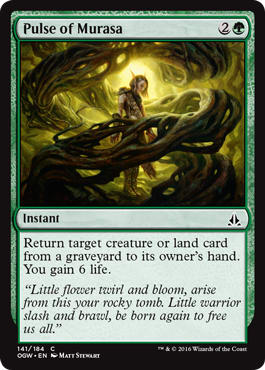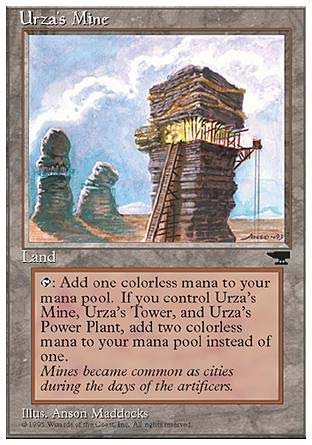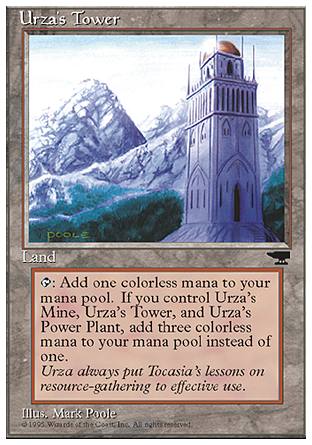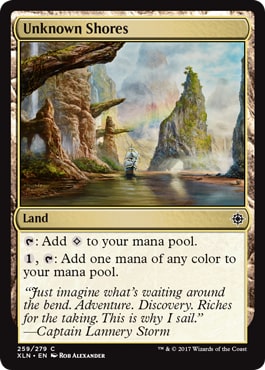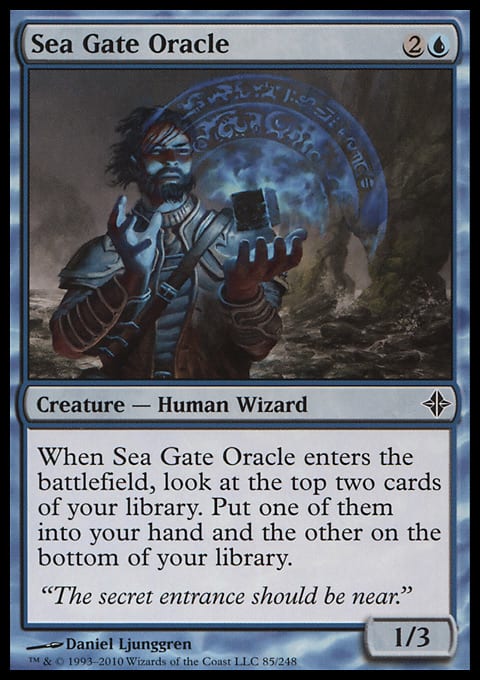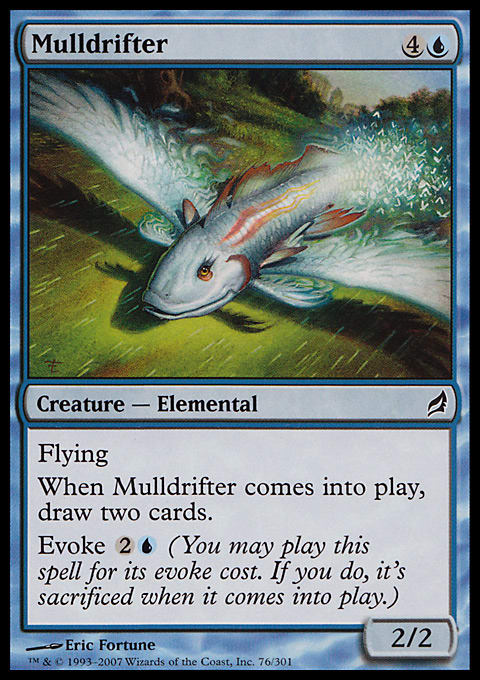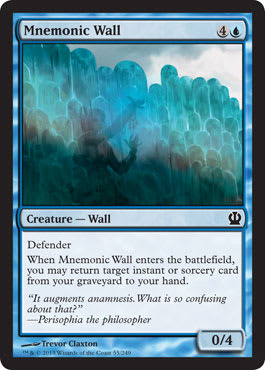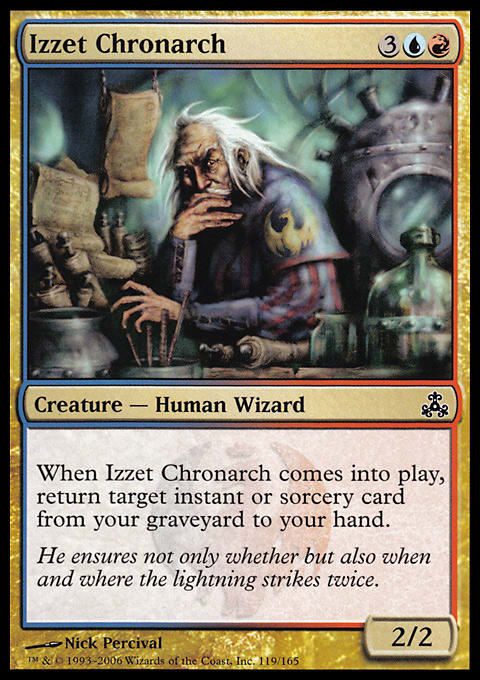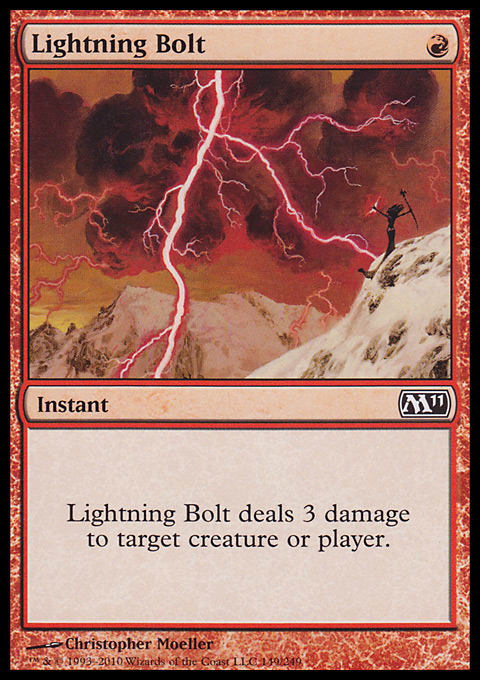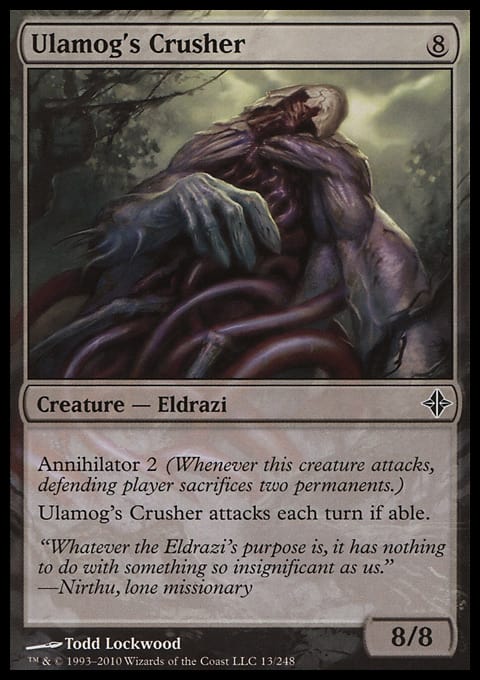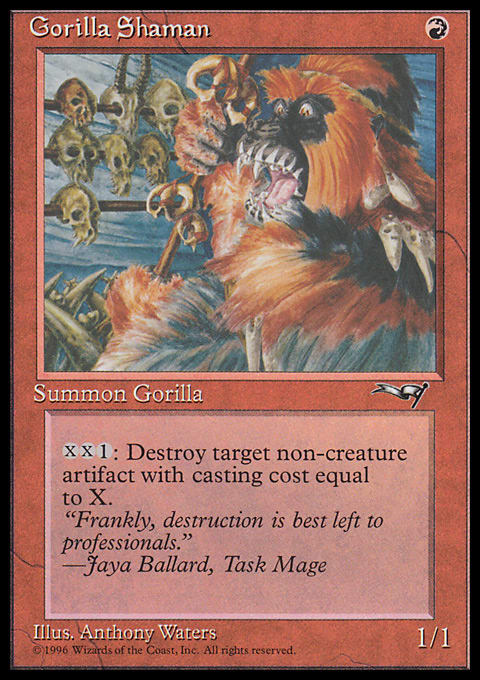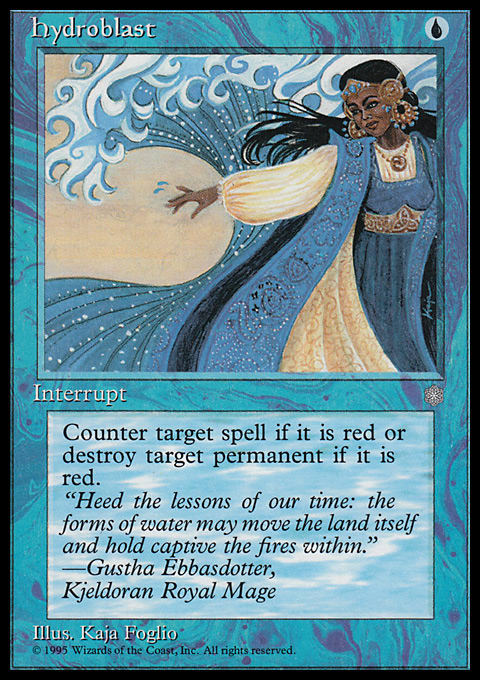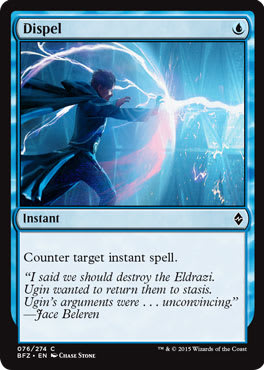I am not a control player by nature. Given my druthers, I would rather try to protect a Werebear with Rune Snag or grind out games with Grim Harvest and Yavimaya Elder. So when I say I cannot remember the last time I had this much fun playing a deck, there is no one more surprised than I am that it is about as pure control as you can get.
The deck is an updated version of the Pulse of Murasa–powered Izzet Tron deck, lovingly referred to as MU/Rasa Tron, I wrote about last week. Here is my latest version of the deck:
MU/Rasa Tron ? Pauper | Alex Ullman
- Creatures (10)
- 1 Izzet Chronarch
- 1 Mnemonic Wall
- 4 Mulldrifter
- 4 Sea Gate Oracle
- Spells (27)
- 1 Capsize
- 1 Exclude
- 1 Into the Roil
- 1 Prohibit
- 1 Twin Bolt
- 2 Counterspell
- 3 Condescend
- 3 Lightning Bolt
- 1 Deep Analysis
- 1 Rolling Thunder
- 2 Pulse of Murasa
- 3 Flame Slash
- 3 Ponder
- 4 Prophetic Prism
- Lands (23)
- 3 Island
- 1 Haunted Fengraf
- 1 Unknown Shores
- 2 Izzet Guildgate
- 4 Swiftwater Cliffs
- 4 Urza's Mine
- 4 Urza's Power Plant
- 4 Urza's Tower
- Sideboard (15)
- 2 Gorilla Shaman
- 2 Pyroblast
- 2 Hydroblast
- 2 Dispel
- 2 Negate
- 1 Ulamog's Crusher
- 1 Death Rattle
- 1 Ancient Grudge
- 1 Magma Spray
- 1 Electrickery
Reports have been coming in via Twitter of multiple pilots taking similar lists to 4–1 or 5–0 in the Pauper league. The deck is well-positioned against the current metagame while also being a largely unknown element. Pauper is slow to adapt to new threats, so a deck that bursts on to the scene has a decently sized window to catch the metagame unprepared. But it is more than the fact that MU/Rasa Tron is a new deck—it fills an otherwise vacant hole in the metagame.
In order to more fully understand this, I’m going to pose a hypothetical question: Why would anyone want to play this deck over traditional Tron? The answer is the person does not want to play a combo deck. MU/Rasa Tron may run the Tron mana engine, but at its core, it is a control deck that alternates between draw-go and tap-out speeds. The game plan is to use the early game to establish a mana advantage and accumulate resources. To enact this aspect, the deck deploys a counter suite and removal to ward off threats while employing Sea Gate Oracle as a way to find key cards and soak up some damage. The midgame comes when Mulldrifters stop being Divinations and start being creatures. Rather than lagging behind in the race, we have caught up to our opponent. The final stage of the game comes when a true mana advantage—either through Tron or just hitting land drops—has been established. At this point, the result has been established: a victory at the hands of Mulldrifter, Capsize lock, or Rolling Thunder.
The key to making it to the late game resides in Pulse of Murasa. In the earlier stages of the game, it represents at least one turn of assault on a life total. Regrowing a blocker can often represent 10 points of life saved as well as additional cards. As the game progresses, Pulse of Murasa represents more cards via Mulldrifter and the ability to put the game completely out of reach of red decks.
It is this last piece that helps to contribute to the early success. Out of the decks comprising at least 5% of the undefeated metagame, five are dedicated red decks: Affinity, Goblins, Izzet Blitz, Kuldotha Jeskai, and Burn. Together, this accounts for over 40% of the reported undefeated decks, and not one of them is a bad matchup. MU/Rasa Tron can struggle against some other heavily played decks, notably Traditional Tron and certain builds of Mono-Black Control. Dimir Teachings can also be problematic, but it is far from a bad matchup. A quick or protected Gurmag Angler is dangerous and has necessitated some changes from the earliest build. The toughest matchup is probably Hexproof, as that deck can easily stick a threat and make it rather imposing quickly. Thankfully, many of the current versions of Hexproof are run dead cards like Manamorphose, and it helps provide the time needed to establish a commanding position.
MU/Rasa Tron is a highly flexible deck. There are some slots that should not be touched, but the rest of the deck is incredibly mutable. These slots tell me that the deck is likely to be able to adapt to future shifts in the popular decks. The follow cards should never leave the deck.
4 Urza's Mine, 4 Urza's Power Plant, 4 Urza's Tower
I mean, the deck is called Tron, after all. In all seriousness, this package allows the deck to establish a stranglehold on the late game. Very few cards in the deck have a serious commitment to specific colors of mana, so being able to tap three lands for a Mulldrifter and have mana left available provides a huge advantage and lets the deck rocket ahead of opponents once the Tron is assembled.
4 Swiftwater Cliffs, 2 Izzet Guildgate
This is one of the few concessions to mana we have to make. Being a deck with an Izzet core, we need access to both blue and red mana. Swiftwater Cliffs is great, as it helps to pad the life total. The Guildgate is fine, but it is needed as a land that casts all our non-Pulse spells. Izzet Boilerworks would seem to be a natural inclusion. The fact that so many of our blue and red sources come into play tapped means that the Boilerworks would be far too tempo-negative, and that offsets the benefits gained by guaranteeing an additional land drop.
2 Island
Access to blue matters early for Impulse, Sea Gate Oracle, and Condescend. Ideally, we want an untapped blue source by turn two, and Island ups our chances of this occurring. It is possible that the third Island the build presented should be another copy of Izzet Guildgate.
1 Unknown Shores
Shimmering Grotto is also acceptable, but I enjoy the new art from Oath of the Gatewatch. These lands give us access to all of our colors in games in which our opponents try to attack Prophetic Prism. Speaking of . . .
4 Prophetic Prism
Replacing itself while fixing mana, Prophetic Prism is an underappreciated all-star in Tron decks. One of the hardest decisions against an unknown opponent is whether to cast Prism on turn two with a Condescend in hand. There is no easy answer, as it often depends on the further contents of your hand. Need to hit a land drop? Condescend may be better. Want access to ![]()
![]() for Counterspell? Maybe you need to risk the investment.
for Counterspell? Maybe you need to risk the investment.
2 Pulse of Murasa
The namesake of the deck, Pulse of Murasa is what ties the deck together. It lets us take damage early and trade creatures off only to recoup the losses later. Gaining 6 life puts us out of the range of decks that are geared toward doing approximately 20 damage. Pulse provides a natural defense to decks that try to blow up our lands as well.
Pulse of Murasa opens up multiple lines of play not previously available to the deck. It makes taking early damage more palatable to also incentivizes chump-blocking. With one of our creatures that can retrieve an instant from the graveyard, it represents an endless loop of chump-blocks. Add a Capsize to the mix, and suddenly, the life total can climb ever higher. Pulse of Murasa also makes evoking Mulldrifter a much more enticing option, as it can just sit in the graveyard and represent 6 life at some point in the future.
3 Sea Gate Oracle
Sleight of Hand is a very good card. A Sleight of Hand that can also absorb some damage is fantastic. Sea Gate Oracle does everything we want. It helps us find whatever we need in the moment while buying time.
3 Mulldrifter
Here’s our main source of card advantage. Mulldrifter does so much work in this build. In matchups in which you are not worried about taking damage, it can be evoked on turn three and then rebought later with Pulse of Murasa. The flying fish also represents a solid clock in the air and, like the Oracle, can soak up damage.
1 Mnemonic Wall, 1 Izzet Chronarch
We take a spell-based approach to the game, and having creatures that can draw us any spell from our graveyard makes it easier to trade spells early. Access to these cards makes running fewer copies of spells like Flame Slash possible, as we have access to additional casts in the late game. I consider the one-and-one split vital, as Wall is a better blocker and Chronarch lets us trade with 2/2s and larger thanks to burn spells.
2 Counterspell
Sometimes, we just have to say no. Having access to double-blue is not guaranteed, but the ability to just say no to your adversary’s best threat is too powerful to ignore. There are spells you need to resolve and some you need to stop, and Counterspell enables both.
3 Condescend
Condescend is great early if you are on the play. After that, its value declines until Tron is online, and then it reclaims its greatness. The ability to interact with your opponent while also digging for cards makes this counter a must-have.
3 Lightning Bolt, 2 Flame Slash
We aren’t able to counter everything, and these two hit just about everything in the format. As long as Izzet Blitz is running rampant, I cannot see myself running fewer than three copies of Flame Slash.
You may note that, in this build, we have moved away from Impulse to Ponder. Impulse is great, but since we are using this slot in the early game to set up future turns, Ponder is nearly as effective. Ponder also has the advantage of shuffling our deck, which matters if we scry away key spells early with Condescend or Sea Gate Oracle.
In the sideboard, I would always run two copies of Pyroblast, Hydroblast, Negate, and Dispel. This suite allows us to fight counter wars and red decks. Including one Ulamog's Crusher gives us an out in games in which we need to attack for the win. I am a fan of a single Death Rattle for attempting to fight Gurmag Angler, but Lightning Axe has proved effective as well.
So How about Those Matchups?
Affinity — One reason to play red in the current metagame is for access to Gorilla Shaman. An early Gorilla Shaman in a deck without Tron can wreak havoc on an Affinity player’s mana base. With Tron, it can become downright brutal. Side out fewer effective removal spells and some number of Condescends and other non-Counterspell counters, depending on whether you are on the play or draw, for Shaman and Hydroblast. Also consider bringing in Dispel if the opponent has both Fling and Temur Battle Rage.
Tron — In all my league runs, I have yet to face another Tron deck, but others have. They have told me the matchup is not favorable, but far from unwinnable. A single Fangren Marauder is not worrisome. The key is to not let the opponent resolve enough 5/5s to kill you and to avoid a lethal Ulamog's Crusher or Rolling Thunder. Games can go long and will often involve casting multiple Rolling Thunders, recurred via Capsize on Mnemonic Wall. Be prepared to slog. Negate is a strong inclusion post-’board, as is all the artifact hate to help keep the opponent off access to specific colors of mana.
Mono-Black Control — If Mono-Black Control can chain multiple copies of Chittering Rats into Gray Merchant of Asphodel, it can be hard for us to keep up. Builds that run Liliana's Specter can be a challenge, as they can leverage Specter and Unearth to nab two cards (a counterspell and whatever will end up discarded). After sideboarding, you want Negates to protect against Choking Sands.
I predict Mono-Black Control will be a problem deck for MU/Rasa Tron for as long as both exist in the metagame. Mono-Black operates on the enters-the-battlefield axis, so Tron would need to overload on cheap counters to try to keep up. The cost of doing so is not worth the negative impact on other matchups.
Goblins — If you can survive to turn four, you are in good shape. Try to not let Foundry Street Denizen, Mogg Raider, and Goblin Sledder survive, as they have the potential to deal a large amount of damage in short order. Again, Hydroblast is an important inclusion. Be on the lookout for Raze, as Goblins will try to sneak one past your defenses.
Kuldotha Jeskai — This deck is very good at dealing 20 points of damage. Asking the Jeskai player to deal any more presents a challenge. Keep the opponent’s flying creatures off the table, and resolve a Pulse of Murasa. At that point, it will be a struggle for him or her to come back. Bring in Ancient Grudge and Gorilla Shaman to attack his or her key components and Ulamog's Crusher to apply pressure. Hydroblast does great work in keeping you alive. You want to retain access to bounce to negate the value of the opponent’s copies of Journey to Nowhere.
Izzet Blitz — Stop the opponent’s threats. That is the key to winning this matchup, and it is why three copies of Flame Slash are so important. Delver of Secrets can survive for a few turns, but Kiln Fiend and Nivix Cyclops should not be allowed to see an untap step if at all possible. Casting Pulse of Murasa in response to lethal damage can often be enough to win the game. Bring in early interaction; Hydroblast and Pyroblast both make sense. Adding Crusher as a way to quickly close out games does not hurt.
Delver — This is still present, but the blue menace is severely weakened. Try to prevent the opponent from pulling ahead on cards through Faerie Miscreant and Ninja of the Deep Hours, but be careful, as Spellstutter Sprite is strong against our removal suite. Bring in Dispel and Pyroblast to win counter wars and Ancient Grudge to take out opposing Spire Golems.
Dimir Delver — Stop Angler, and you are in pretty good shape. A lot of this deck is dedicated to resolving an early Zombie Fish, so do your best to keep the 5/5 from hitting the table. After that, mop up with your own flying fish and Rolling Thunder. Dispel and Pyroblast are solid additions, and Negate is not a dead card.
Burn — Like Affinity, Jeskai, and Goblins, the goal is to stay alive. A single Pulse of Murasa buys you a ton of time, and a second one can be backbreaking. Side out your removal for counters and Crusher, and it is hard to lose.
Dimir Teachings — This is another slog. These decks only have a few relevant spells: Gurmag Angler, Curse of the Bloody Tome, and Evincar's Justice. Do your best to stop those from resolving. The issue is that Teachings has access to more counters and can save them for spells since this deck also overloads on removal. The matchup is far from bad, but it is not great either. A lot will come down to whether Tron draws the right half of the deck in Game 1 and sides out dead copies of Lightning Bolt in Game 2. Dispel, Negate, Pyroblast, and any other cards designed for a long game shine in this matchup.
Stompy — If the player are is not running Silhana Ledgewalker, you want to play this similarly to Goblins, except you counter Rancors and Bonesplitters. Survive long enough to let your superior spells take over the game. Block often, as staying above 9 life is key—two copies of Groundswell can make any creature lethal in a hurry. Ledgewalker is problematic, as it dodges all of our removal. It is one reason Hexproof—a fringe deck at best—is so strong against our deck. Bring in Crusher and any extra cheap removal you may have. Dispel also may make sense if the opponent is heavy on pump spells. Hunger of the Howlpack is a card to be aware of when blocking and aiming Lightning Bolts at creatures—having a backup burn spell is not a bad plan.
MU/Rasa Tron is a powerful deck with the ability to adapt to changing metagame trends. While the core should remain untouched, the flexibility in its answer slots and the fact that it can easily splash off-color spells tells me it should remain a force for the foreseeable future. The best way to beat the deck is to try to go underneath its answers. Hexproof creatures are problematic, and any deck that can flood the board quickly and present multiple threats—say with a Raise the Alarm—may prove to expose another weakness. But for now, I’m just having too much fun.
















